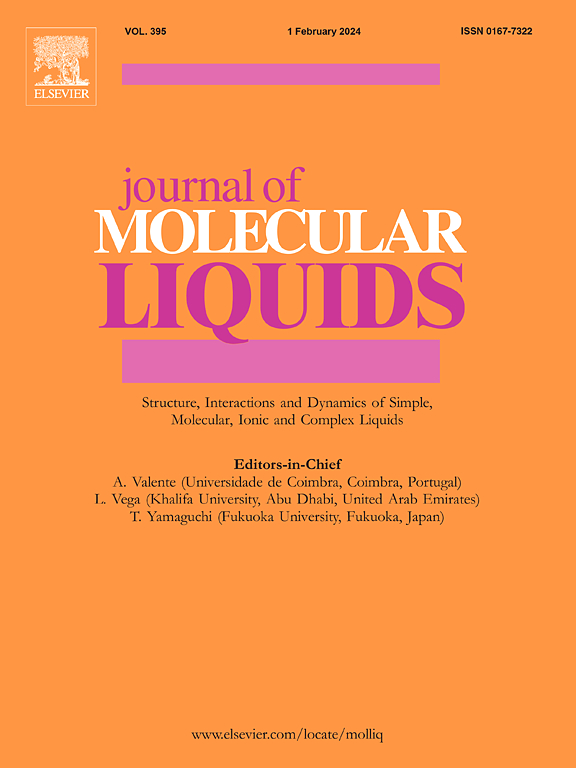新型双金属有机框架对水溶液中除草剂百草枯的吸附和去除:动力学、平衡和统计表面建模
IF 5.3
2区 化学
Q2 CHEMISTRY, PHYSICAL
引用次数: 0
摘要
本研究探讨了除草剂百草枯与一种称为铽/钯金属有机框架(Tb/Pd-MOF)的双金属有机框架的吸附和去除关系。用于评估铽/钯金属有机框架特性的 N2 吸附/解吸等温线分析表明,铽/钯金属有机框架对百草枯的吸收导致孔隙体积、孔径和表面积减小。具体来说,孔隙体积从 8.25 cm3/g 减小到 5.68 cm3/g,孔径从 11.34 nm 减小到 8.92 nm,表面积从 1456.61 m2/g 减小到 1262.82 m2/g。孔隙半径也从 0.96 nm 减小到 0.58 nm。通过傅立叶变换红外光谱确定了 Tb/Pd-MOF 的官能团,并用 XPS 确认了化合物的结构。研究了各种吸附参数,包括温度、吸附剂用量、pH 值、百草枯浓度和接触时间。密度泛函理论(DFT)用于了解百草枯的电学性质、反应活性和形态。DFT 分析结果表明,亲电和亲核攻击位点与分子轨道(HOMO 和 LUMO)和 MEP 结果一致。研究发现,锑/钯-MOF 对百草枯具有显著的吸附能力,其吸附数据符合朗缪尔等温线和伪二阶动力学模型。经测定,锑/钯-MOF 的百草枯吸附能力为 574.8 毫克/克。此外,吸附能为 26.98 kJ-mol-1,表明化学吸附是主要的吸附形式。获得高吸附容量的最佳条件是 pH 值为 8 和 0.02 克锑/钯-MOF。热力学参数 ΔG°、ΔH° 和 ΔS° 随温度的变化表明,锑/钯-MOF 对百草枯的吸收是自发的、内热的和随机的。为了优化吸收过程,研究人员采用了响应面方法和盒式贝肯设计(RSM,BBD)。这些技术使得百草枯能从锑/钯-MOF 材料中有效去除。在化学吸附过程中,吸附剂和吸附剂形成化学键,而芳香环则参与π-π键。此外,当吸附剂充满吸附剂的孔隙时,就会发生孔隙填充,而吸附剂和吸附剂之间电荷的吸引或排斥则会产生静电作用。作为消除废水中百草枯的一种方法,Tb/Pd-MOF 因其多样化的吸收过程和高吸附能力而显示出巨大的潜力。本文章由计算机程序翻译,如有差异,请以英文原文为准。

Adsorption and removal of herbicide paraquat from aqueous solutions via novel bimetal organic framework: Kinetics, equilibrium and statistical surface modeling
This study examines the adsorption and removal of the herbicide paraquat in relation to a bimetal organic framework known as the Terbium/Palladium Metal-Organic Framework (Tb/Pd-MOF). Analysis of N2 adsorption/desorption isotherms, which were used to assess the properties of the Tb/Pd-MOF, revealed that the absorption of paraquat on Tb/Pd-MOF resulted in a reduction in pore volume, pore size, and surface area. Specifically, the pore volume decreased from 8.25 to 5.68 cm3/g, the pore size decreased from 11.34 nm to 8.92 nm, and the surface area decreased from 1456.61 to 1262.82 m2/g. The pore radius also decreased from 0.96 nm to 0.58 nm. Tb/Pd-MOF’s functional groups were identified through FT-IR, and the structure of the compound was confirmed using XPS. Various adsorption parameters including temperature, adsorbent dosage, pH, paraquat concentration, and contact time were studied. Density functional theory (DFT) was used to understand the electrical properties, reactivity, and morphology of paraquat. Results from the DFT analysis revealed that the electrophilic and nucleophilic attack sites aligned with the molecular orbitals (HOMO and LUMO) and MEP outcomes. The study found that Tb/Pd-MOF demonstrated a significant absorption capacity for paraquat, with adsorption data consistent with the Langmuir isotherm and pseudo-second-order kinetic models. The paraquat adsorption capability of Tb/Pd-MOF was determined to be 574.8 mg/g. Furthermore, chemisorption was identified as the primary form of adsorption, as indicated by the adsorption energy of 26.98 kJ·mol−1. The optimal conditions for achieving a high adsorption capacity were identified as pH 8 and 0.02 g of Tb/Pd-MOF. The temperature-dependent changes in the thermodynamic parameters ΔG°, ΔH°, and ΔS° indicated that the paraquat absorption onto Tb/Pd-MOF occurred spontaneously, was endothermic, and involved random processes. To optimize the absorption process, Response Surface Methodology and Box-Behnken design (RSM, BBD) were employed. These techniques enabled effective removal of paraquat from the Tb/Pd-MOF material. During chemisorption, the adsorbate and adsorbent form chemical bonds, while aromatic rings are involved in π-π bonding. Additionally, pore-filling occurs when the adsorbate fills the pores of the adsorbent, and electrostatic interactions result from the attraction or repulsion of charges between the adsorbate and adsorbent. As a means of eliminating paraquat from wastewater, Tb/Pd-MOF demonstrates significant potential due to its diverse absorption processes and high capacity for adsorption.
求助全文
通过发布文献求助,成功后即可免费获取论文全文。
去求助
来源期刊

Journal of Molecular Liquids
化学-物理:原子、分子和化学物理
CiteScore
10.30
自引率
16.70%
发文量
2597
审稿时长
78 days
期刊介绍:
The journal includes papers in the following areas:
– Simple organic liquids and mixtures
– Ionic liquids
– Surfactant solutions (including micelles and vesicles) and liquid interfaces
– Colloidal solutions and nanoparticles
– Thermotropic and lyotropic liquid crystals
– Ferrofluids
– Water, aqueous solutions and other hydrogen-bonded liquids
– Lubricants, polymer solutions and melts
– Molten metals and salts
– Phase transitions and critical phenomena in liquids and confined fluids
– Self assembly in complex liquids.– Biomolecules in solution
The emphasis is on the molecular (or microscopic) understanding of particular liquids or liquid systems, especially concerning structure, dynamics and intermolecular forces. The experimental techniques used may include:
– Conventional spectroscopy (mid-IR and far-IR, Raman, NMR, etc.)
– Non-linear optics and time resolved spectroscopy (psec, fsec, asec, ISRS, etc.)
– Light scattering (Rayleigh, Brillouin, PCS, etc.)
– Dielectric relaxation
– X-ray and neutron scattering and diffraction.
Experimental studies, computer simulations (MD or MC) and analytical theory will be considered for publication; papers just reporting experimental results that do not contribute to the understanding of the fundamentals of molecular and ionic liquids will not be accepted. Only papers of a non-routine nature and advancing the field will be considered for publication.
 求助内容:
求助内容: 应助结果提醒方式:
应助结果提醒方式:


